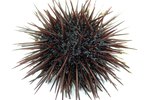
More than 30 species of box jellyfish are known, but little is known about the life cycles and reproduction of most of them. What is known about the box jellyfish has been gleaned from studying Chironex fleckeri. According to this research, adult box jellyfish seems to have little interaction with their young.
Adult Jellyfish & Fertilization
Once each year, male and female box jellyfish mate. In most observed species, the jellyfish pair up to reproduce. According to the University of California Museum of Paleontology, at least one box jellyfish species has been known to gather in a large group to mate. Some species' males fertilize the eggs inside the female, but the Chironex fleckeri females release eggs into the water and the males release sperm so the fertilization occurs outside the female’s body. In either case, once the eggs are fertilized, they develop into planulae. For some species, this development occurs inside the female’s body. For the Chironex fleckeri, however, it occurs in the water.
The Planulae
Box jellyfish males apparently have no further responsibility for their young after fertilization occurs. Some females carry fertilized eggs for a short time before releasing the developed planulae into the water. At that point, the adult jellyfish provide no further care for their young. In fact, most species appear to die soon after fertilization occurs. The planulae remain floating in the water for several days. Finally, the planulae will land on the bottom of the ocean and enter a new stage of development.
Polyps & Medusas
Planulae actually reproduce through a process known as budding, a type of asexual reproduction. Each bud -- known as a polyp -- is essentially a copy of the planula. The jellyfish polyps will spend months floating near the substrate eating and growing. Then each of the polyps changes into a medusa, a smaller version of a jellyfish. The medusa detaches from the rest of the polyps and swims off.
From Medusa to Deadly Adult
Medusas continue to grow after they swim away from their siblings. However, little is known about this stage of box jellyfish life. According to Matt Gordon, a doctoral candidate in Queensland, researchers know the jellyfish change from polyps into jellies capable of stinging around September every year. However, the adult versions do not begin appearing around beaches until November. The adult jellyfish will live only a short time before reproducing and dying like their parents. Average life span seems to be between nine months and one year.
References
Photo Credits
-
Jupiterimages/Photos.com/Getty Images
Writer Bio
Amy Jorgensen has ghostwritten more than 100 articles and books on raising and training animals. She is also an amateur dog trainer. She has also written more than 200 blog posts, articles, and ebooks on wedding and party planning on behalf of professionals in the field.




